https://www.thedrive.com/the-war-zo...-artificial-intelligence-combat-drone-program
Glitzy Air Force Video Lays Out "Skyborg" Artificial Intelligence Combat Drone Program
The presentation outlines potential future mission sets, including air-to-air combat, and how the drones will fit into the service's larger plans.
BY JOSEPH TREVITHICKJUNE 24, 2020
The U.S. Air Force has released a slick new video regarding its Skyborg program, which is developing a suite of systems that will form an artificial intelligence-driven "computer brain" capable of flying networked "loyal wingman" type drones and fully autonomous unmanned combat air vehicles, or UCAVs. The video offers new insights into what the service wants out of this project, how it sees it fitting into its larger aerial combat ecosystem, and what unmanned capabilities it might serve as a stepping stone toward in the future.
THE FIGHT FOR THE AIR FORCE'S "SKYBORG" ARTIFICIAL INTELLIGENCE EQUIPPED DRONES HAS BEGUNBy Joseph TrevithickPosted in THE WAR ZONE
USAF PLANS FOR ITS "SKYBORG" AI COMPUTER BRAIN TO BE FLYING DRONES IN THE NEXT TWO YEARSBy Joseph TrevithickPosted in THE WAR ZONE
MANNED FIGHTER TO FACE AUTONOMOUS DRONE NEXT YEAR IN SCI-FI MOVIE-LIKE SHOWDOWNBy Joseph TrevithickPosted in THE WAR ZONE
"B-21S WITH AIR-TO-AIR CAPABILITIES," DRONES, NOT 6TH GEN FIGHTERS TO DOMINATE FUTURE AIR COMBATBy Joseph Trevithick and Tyler RogowayPosted in THE WAR ZONE
THE ALARMING CASE OF THE USAF’S MYSTERIOUSLY MISSING UNMANNED COMBAT AIR VEHICLESBy Tyler RogowayPosted in THE WAR ZONE
The Air Force Research Laboratory (AFRL) posted the video on YouTube on June 24, 2020. AFRL is leading the development of Skyborg, which the Air Force first unveiled publicly in March 2019. The service issued a formal call for proposals regarding work to integrate the various systems into an actual prototype unmanned aircraft last month, saying it expected to hire multiple contractors to craft competing designs.
The new Skyborg video features concept art with additional views of a notional loyal wingman-type drone that AFRL first showed publicly last year. The design, which has clear low-observable (stealthy) features, has a centrally-mounted main wing and v-tail. A top-mounted air intake at the rear of the fuselage feeds into a single small jet engine with a shrouded exhaust.
A cutaway shows a modular equipment bay in the top of the forward fuselage, including what looks to be some kind of sensor, possibly meant to depict an Infrared Search and Track (IRST) system, in the nose. This conceptual aircraft has two internal payload bays underneath the fuselage in between its tricycle landing gear.
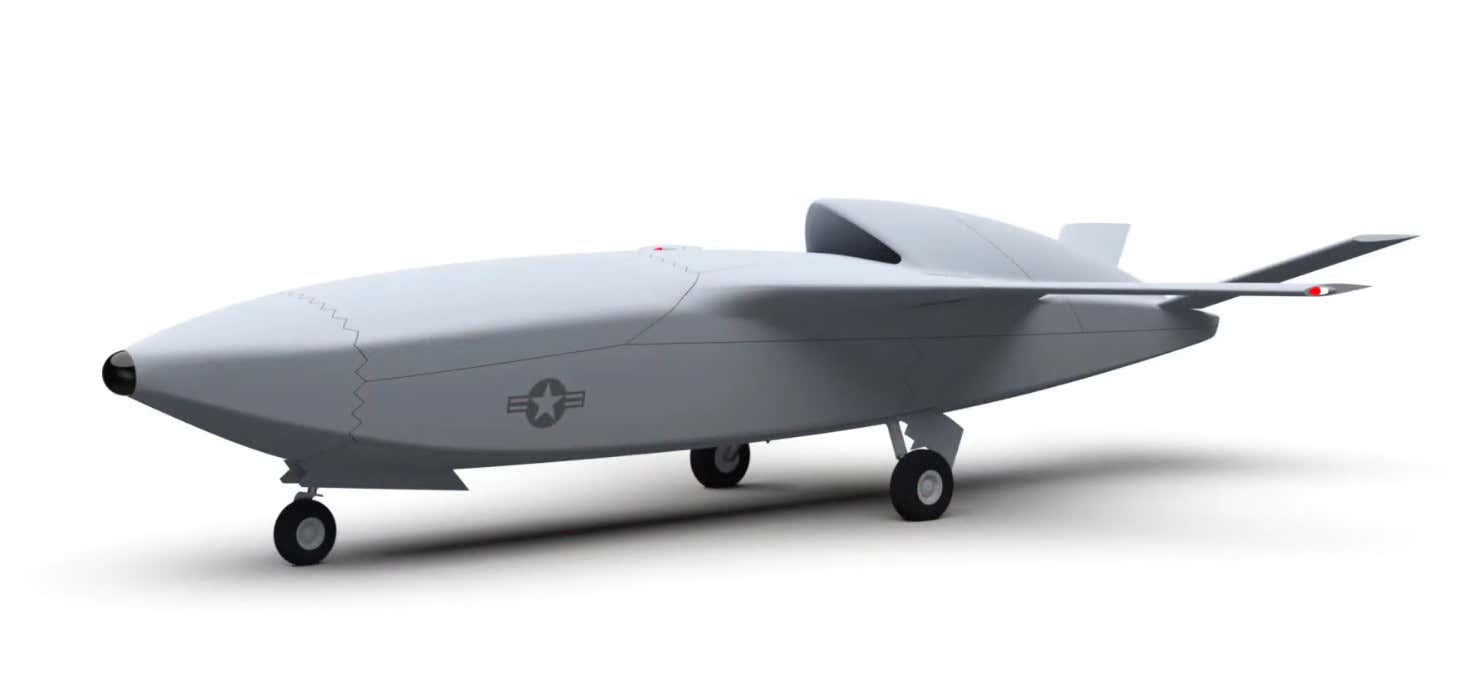
USAF
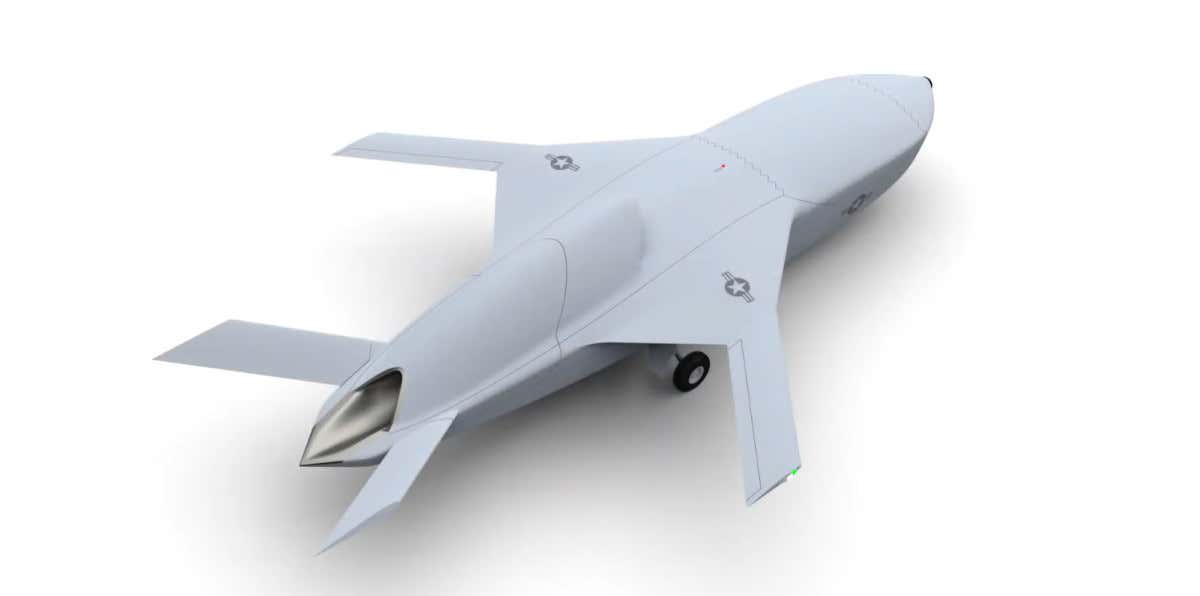
USAF
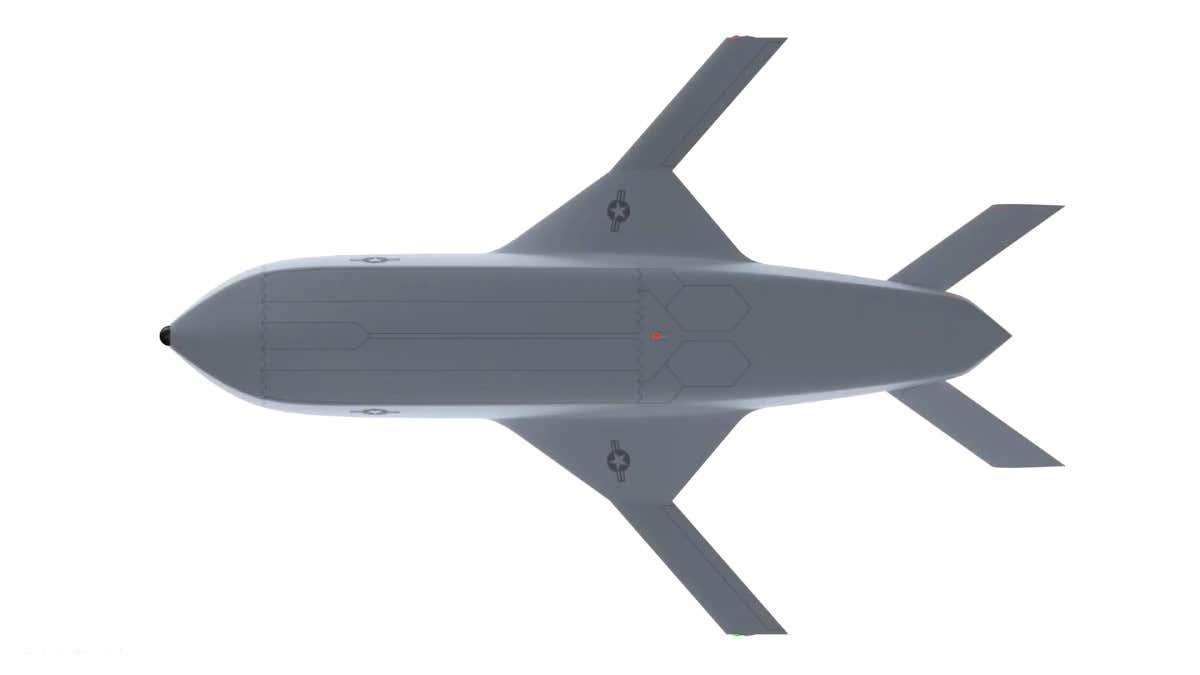
USAF
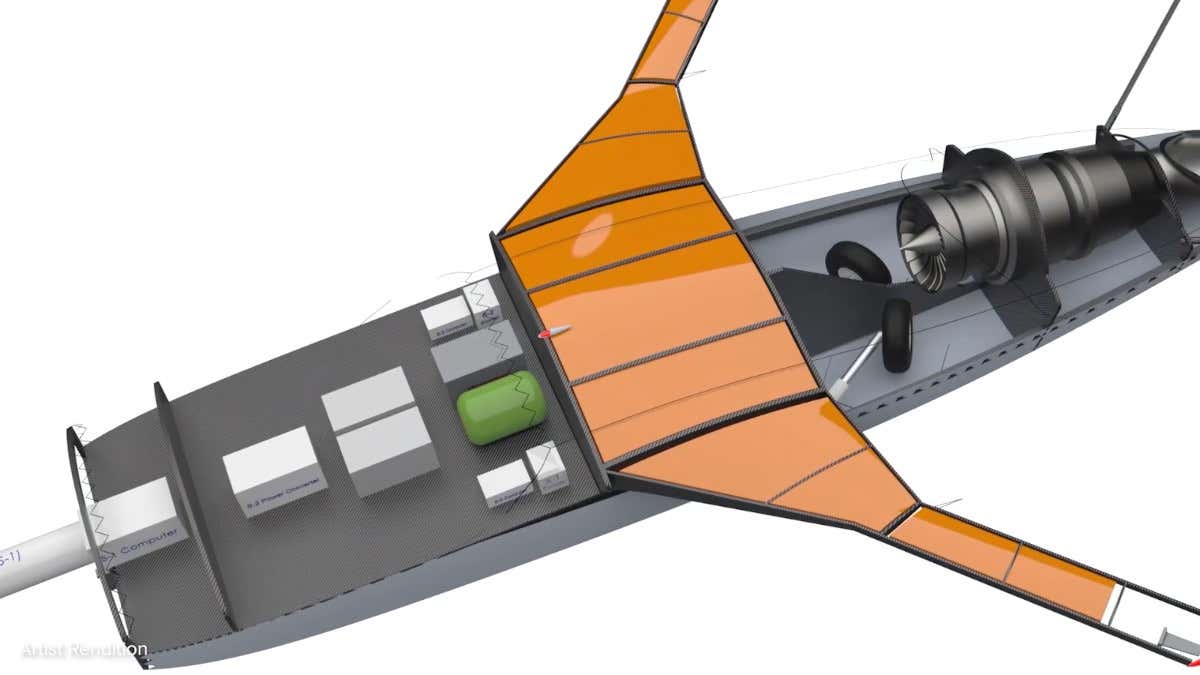
USAF
It's important to note that there is no indication that this design is anything but a concept. However, it does highlight various features that AFRL appears to be interested in seeing on prototype drones for the Skyborg program.
The video also details three general categories of priorities, described as "open," "resilient," and "autonomous" that are driving the Air Force's requirements for the Skyborg system and the platform carrying it.
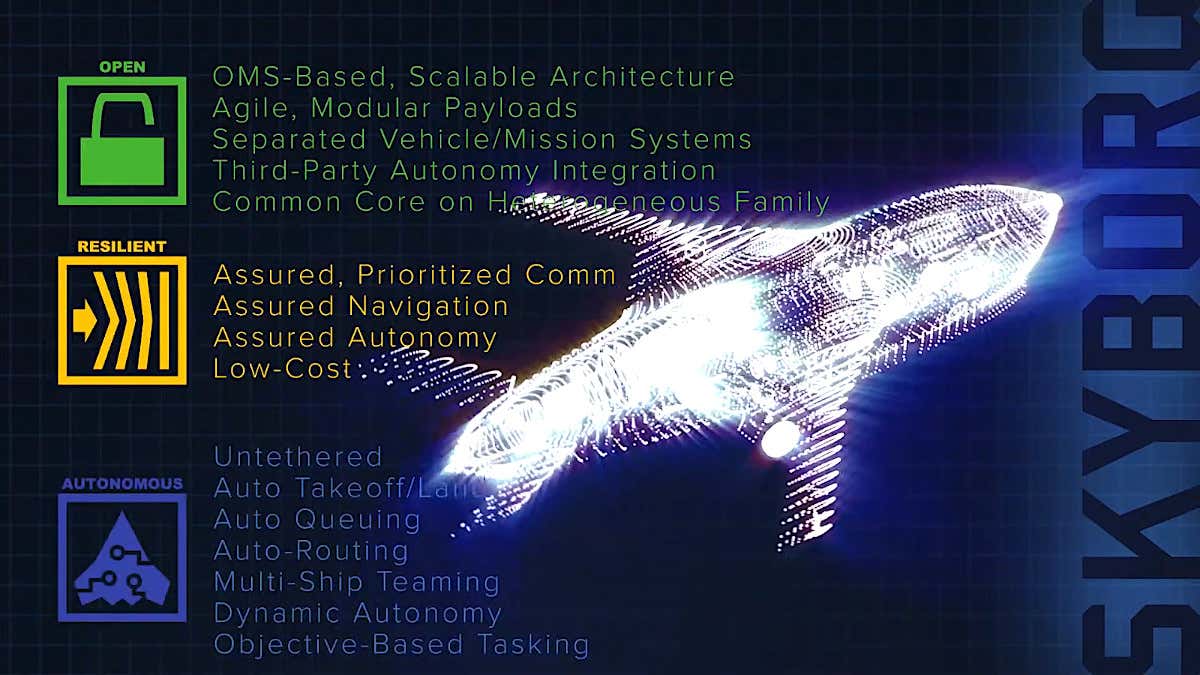
USAF
From when it first announced the project, the Air Force has focused heavily on its goals for Skyborg to use open-architecture and modular systems to enable the rapid insertion of new functionality and capabilities as time goes on by parties that might not have even been involved in its original development. The video also highlights the fact that the Skyborg systems are intended to be scalable and work on various platforms.
AFRL has said in the past that the initial goal is to test Skyborg on a loyal wingman-type drone before moving on to a fighter jet-sized UCAV and that the systems could potentially find their way into manned aircraft, where they would act as a sort of artificial intelligence-driven virtual co-pilot. The Air Force has a separate effort underway, dubbed R2D2, after the famous droid from the Star Wars franchise who serves as a sort of robotic navigator and flight engineer, to develop a drone with a more robust autonomous air-to-air capability that could face off against a human fighter pilot as early as next year. You can read more about that project in this past War Zone piece.
When it comes to Skyborg's resiliency, what the Air Force means is that it has to have assured communications and navigation, as well as autonomy capabilities that will work even if its links to the outside world are jammed or spoofed. The need for aircraft, manned and unmanned, weapons, and other systems that can function in GPS-denied environments is a particularly important area of interest across the U.S. military. There is already extensive work being done on means of providing what is called Assured Position, Navigation, and Timing (PNT), which you can read about more in this previous War Zone story.
There is a desire to keep the Skyborg systems, as well as the platforms carrying them, as low-cost as possible, too. The loyal wingman drones that the Air Force is exploring now are specifically supposed to be "attritable," meaning that they would be cheap enough that commanders could employ them in situations where there would be greater risks of them not returning that would otherwise preclude the use of a more traditional reusable platform.
As far as autonomy goes, the Air Force wants Skyborg to be capable of performing a broad range of tasks all by itself, ranging from simple things, such as taking off and landing, to more complex functionality, including making independent decisions dynamically based on various situational factors or a pre-defined objective. Drones with Skyborg would also be able to operate in networked groups tethered to manned aircraft in a loyal wingman capacity or operate fully untethered in an autonomous mode.
The video includes a breakdown, seen below, of four more specific lines of effort that AFRL is pursuing with regards to Skyborg in support its broader goals.
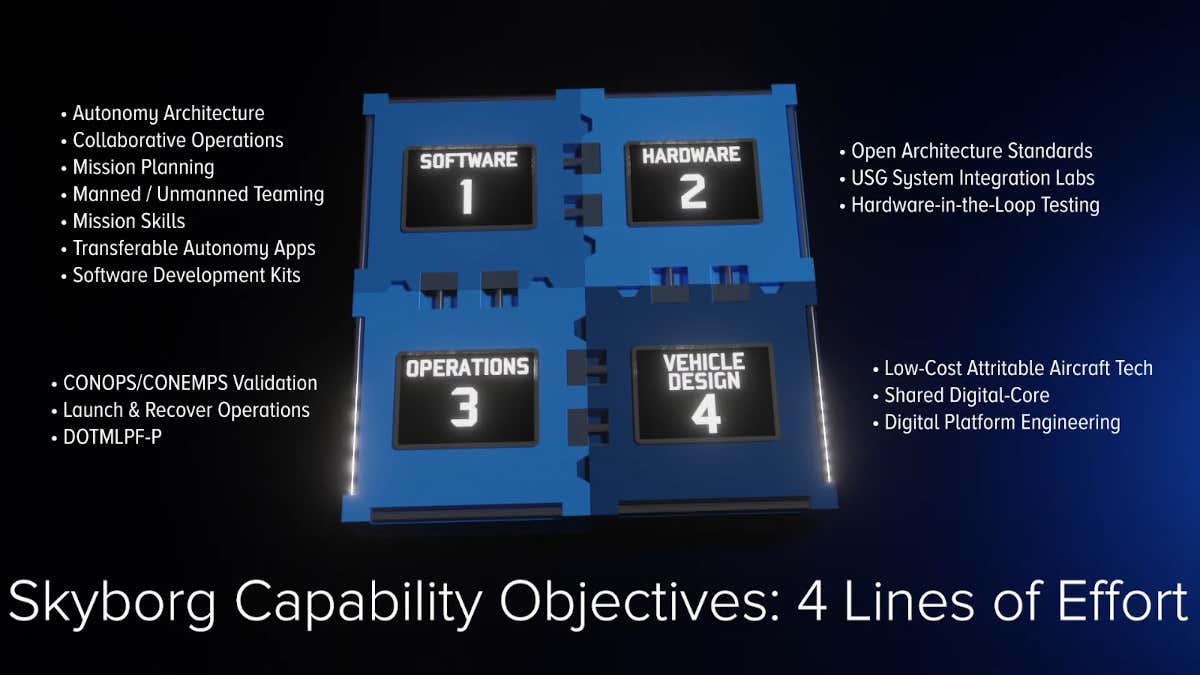
USAF
With all this in mind, the video also includes a very interesting diagram showing how Skyborg would fit into the Air Force's larger aerial combat ecosystem. Drones with the system would be primarily tasked with operating in contested areas, while non-stealthy manned aircraft would operate in uncontested environments. Stealth manned and unmanned platforms, potentially including true UCAVs, as well as expendable drones, which might include swarms of small unmanned aircraft, would take the fight into highly contested areas.
Skyborg-equipped attritable drones, operating in this middle region, could support a wide variety of mission sets, including air-to-air and air-ground combat – described in the video as "OCA/DCA," or Offensive Counter Air/Defense Counter Air, and "Munitions" – and intelligence, surveillance, and reconnaissance (IRS) tasks. It also mentions that some of these unmanned aircraft could carry elements of the future Advanced Battle Management System (ABMS), a command and control, communications, and data-sharing network architecture that the Air Force is working on separately.
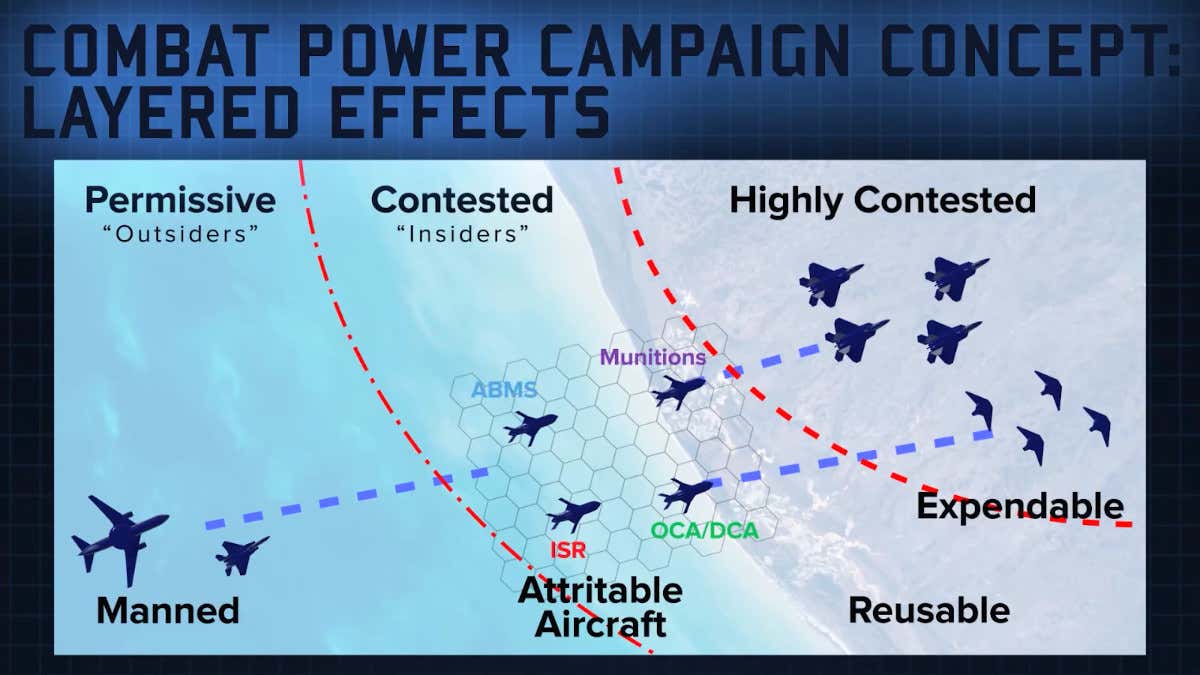
USAF CAPTURE
Using these drones as communications and data-sharing nodes could be vital for sending critical information back and forth quickly between aircraft in the uncontested region and the highly contested region. The service has already been experimenting with the Kratos XQ-58A Valkyrie drone, which is also a frontrunner to carry the prototype Skyborg systems, in this relay role.
The video indicates that Skyborg could ultimately support even more missions, such as close air support, interdiction, and "Next-Gen ISR/Strike," the latter of which could refer to penetrating unmanned platforms including UCAVs. The Air Force is in the process of exploring future aerial combat concepts as part of its Next Generation Air Dominance (NGAD) program. The video closes with a computer-generated clip of AFRL's concept drone launching an AIM-120 Advanced Medium-Range Air-to-Air Missile (AMRAAM).
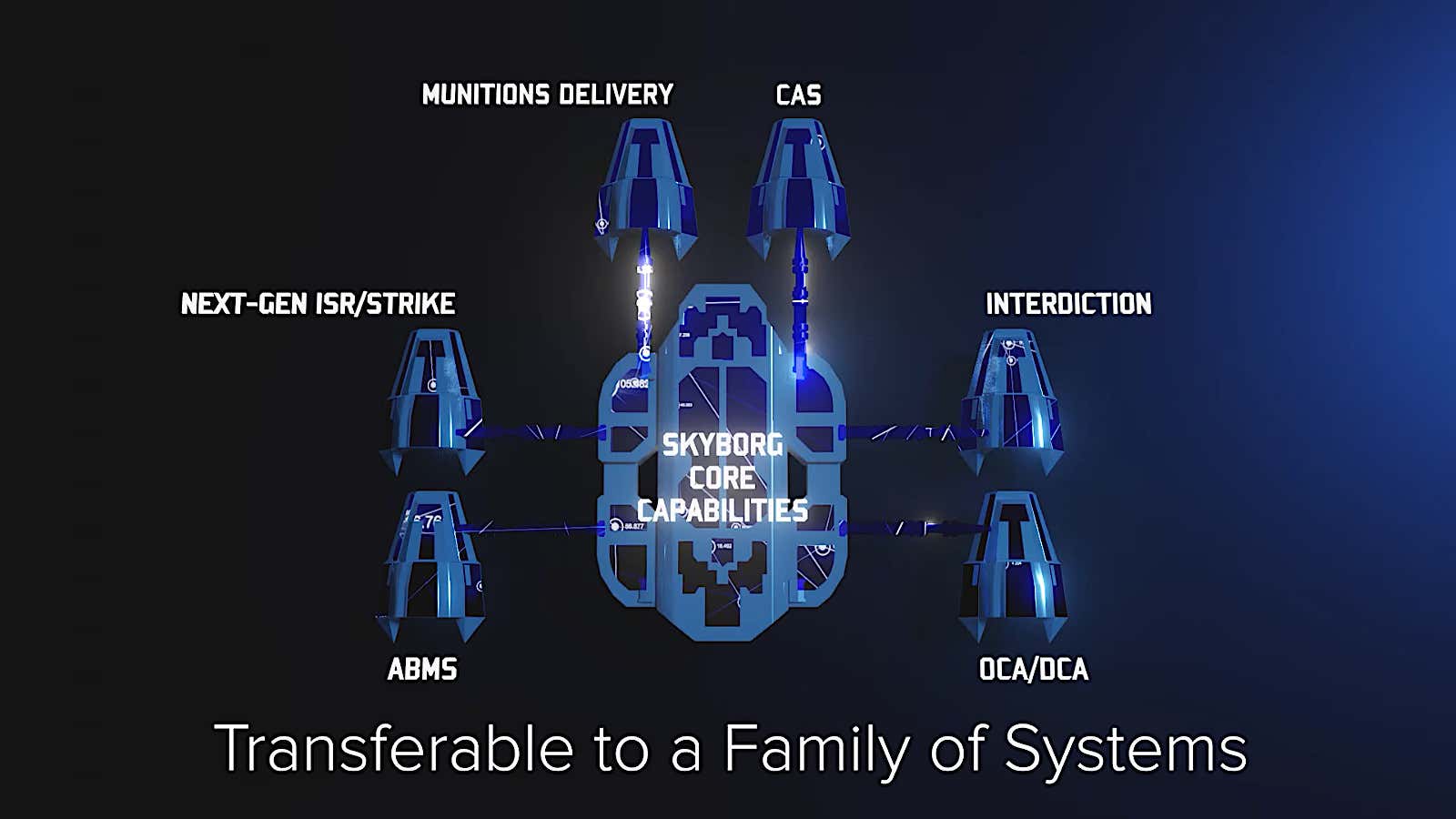
USAF
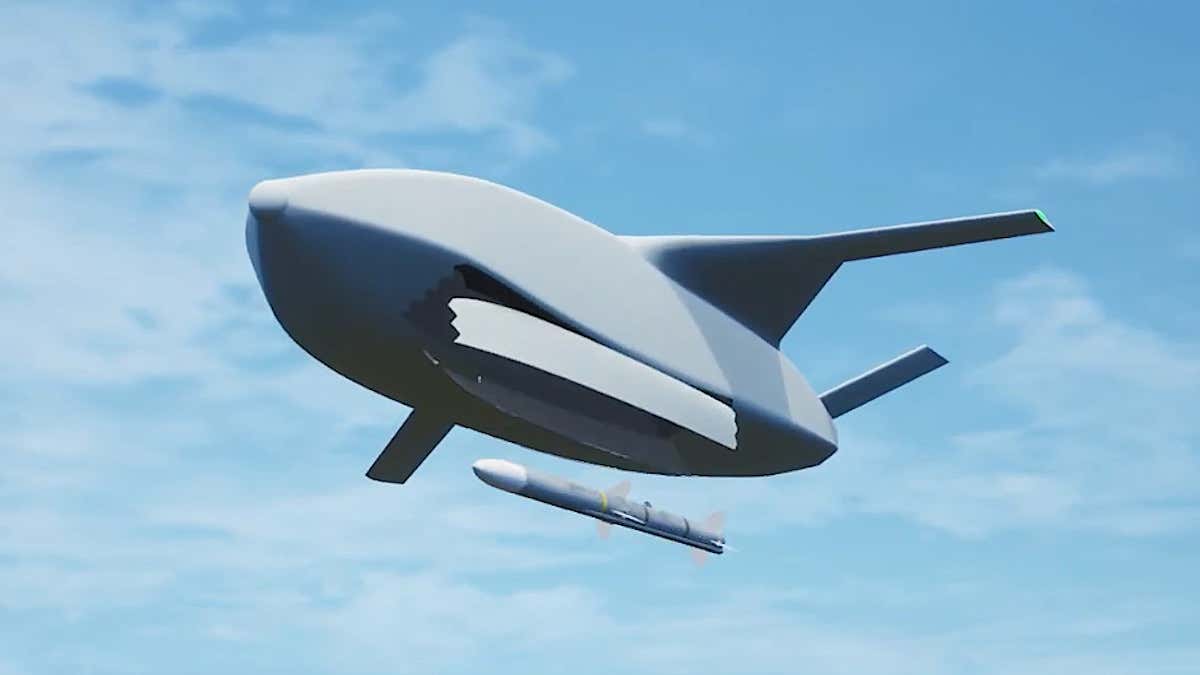
USAF
The Air Force has said it is hoping to have a prototype version Skyborg ready next year and an operational version of the system flying a loyal wingman type drone by 2023. Knowing more now about AFRL's larger goals, it will be very exciting to see how the program progresses and how the system evolves to take on additional roles in the future.
Contact the author: [email protected]
DON'T FORGET TO SIGN UP
YOUR EMAIL ADDRESS
MORE TO READ
Glitzy Air Force Video Lays Out "Skyborg" Artificial Intelligence Combat Drone Program
The presentation outlines potential future mission sets, including air-to-air combat, and how the drones will fit into the service's larger plans.
BY JOSEPH TREVITHICKJUNE 24, 2020
The U.S. Air Force has released a slick new video regarding its Skyborg program, which is developing a suite of systems that will form an artificial intelligence-driven "computer brain" capable of flying networked "loyal wingman" type drones and fully autonomous unmanned combat air vehicles, or UCAVs. The video offers new insights into what the service wants out of this project, how it sees it fitting into its larger aerial combat ecosystem, and what unmanned capabilities it might serve as a stepping stone toward in the future.
THE FIGHT FOR THE AIR FORCE'S "SKYBORG" ARTIFICIAL INTELLIGENCE EQUIPPED DRONES HAS BEGUNBy Joseph TrevithickPosted in THE WAR ZONE
USAF PLANS FOR ITS "SKYBORG" AI COMPUTER BRAIN TO BE FLYING DRONES IN THE NEXT TWO YEARSBy Joseph TrevithickPosted in THE WAR ZONE
MANNED FIGHTER TO FACE AUTONOMOUS DRONE NEXT YEAR IN SCI-FI MOVIE-LIKE SHOWDOWNBy Joseph TrevithickPosted in THE WAR ZONE
"B-21S WITH AIR-TO-AIR CAPABILITIES," DRONES, NOT 6TH GEN FIGHTERS TO DOMINATE FUTURE AIR COMBATBy Joseph Trevithick and Tyler RogowayPosted in THE WAR ZONE
THE ALARMING CASE OF THE USAF’S MYSTERIOUSLY MISSING UNMANNED COMBAT AIR VEHICLESBy Tyler RogowayPosted in THE WAR ZONE
The Air Force Research Laboratory (AFRL) posted the video on YouTube on June 24, 2020. AFRL is leading the development of Skyborg, which the Air Force first unveiled publicly in March 2019. The service issued a formal call for proposals regarding work to integrate the various systems into an actual prototype unmanned aircraft last month, saying it expected to hire multiple contractors to craft competing designs.
The new Skyborg video features concept art with additional views of a notional loyal wingman-type drone that AFRL first showed publicly last year. The design, which has clear low-observable (stealthy) features, has a centrally-mounted main wing and v-tail. A top-mounted air intake at the rear of the fuselage feeds into a single small jet engine with a shrouded exhaust.
A cutaway shows a modular equipment bay in the top of the forward fuselage, including what looks to be some kind of sensor, possibly meant to depict an Infrared Search and Track (IRST) system, in the nose. This conceptual aircraft has two internal payload bays underneath the fuselage in between its tricycle landing gear.

USAF

USAF

USAF

USAF
It's important to note that there is no indication that this design is anything but a concept. However, it does highlight various features that AFRL appears to be interested in seeing on prototype drones for the Skyborg program.
The video also details three general categories of priorities, described as "open," "resilient," and "autonomous" that are driving the Air Force's requirements for the Skyborg system and the platform carrying it.

USAF
From when it first announced the project, the Air Force has focused heavily on its goals for Skyborg to use open-architecture and modular systems to enable the rapid insertion of new functionality and capabilities as time goes on by parties that might not have even been involved in its original development. The video also highlights the fact that the Skyborg systems are intended to be scalable and work on various platforms.
AFRL has said in the past that the initial goal is to test Skyborg on a loyal wingman-type drone before moving on to a fighter jet-sized UCAV and that the systems could potentially find their way into manned aircraft, where they would act as a sort of artificial intelligence-driven virtual co-pilot. The Air Force has a separate effort underway, dubbed R2D2, after the famous droid from the Star Wars franchise who serves as a sort of robotic navigator and flight engineer, to develop a drone with a more robust autonomous air-to-air capability that could face off against a human fighter pilot as early as next year. You can read more about that project in this past War Zone piece.
When it comes to Skyborg's resiliency, what the Air Force means is that it has to have assured communications and navigation, as well as autonomy capabilities that will work even if its links to the outside world are jammed or spoofed. The need for aircraft, manned and unmanned, weapons, and other systems that can function in GPS-denied environments is a particularly important area of interest across the U.S. military. There is already extensive work being done on means of providing what is called Assured Position, Navigation, and Timing (PNT), which you can read about more in this previous War Zone story.
There is a desire to keep the Skyborg systems, as well as the platforms carrying them, as low-cost as possible, too. The loyal wingman drones that the Air Force is exploring now are specifically supposed to be "attritable," meaning that they would be cheap enough that commanders could employ them in situations where there would be greater risks of them not returning that would otherwise preclude the use of a more traditional reusable platform.
As far as autonomy goes, the Air Force wants Skyborg to be capable of performing a broad range of tasks all by itself, ranging from simple things, such as taking off and landing, to more complex functionality, including making independent decisions dynamically based on various situational factors or a pre-defined objective. Drones with Skyborg would also be able to operate in networked groups tethered to manned aircraft in a loyal wingman capacity or operate fully untethered in an autonomous mode.
The video includes a breakdown, seen below, of four more specific lines of effort that AFRL is pursuing with regards to Skyborg in support its broader goals.

USAF
With all this in mind, the video also includes a very interesting diagram showing how Skyborg would fit into the Air Force's larger aerial combat ecosystem. Drones with the system would be primarily tasked with operating in contested areas, while non-stealthy manned aircraft would operate in uncontested environments. Stealth manned and unmanned platforms, potentially including true UCAVs, as well as expendable drones, which might include swarms of small unmanned aircraft, would take the fight into highly contested areas.
Skyborg-equipped attritable drones, operating in this middle region, could support a wide variety of mission sets, including air-to-air and air-ground combat – described in the video as "OCA/DCA," or Offensive Counter Air/Defense Counter Air, and "Munitions" – and intelligence, surveillance, and reconnaissance (IRS) tasks. It also mentions that some of these unmanned aircraft could carry elements of the future Advanced Battle Management System (ABMS), a command and control, communications, and data-sharing network architecture that the Air Force is working on separately.

USAF CAPTURE
Using these drones as communications and data-sharing nodes could be vital for sending critical information back and forth quickly between aircraft in the uncontested region and the highly contested region. The service has already been experimenting with the Kratos XQ-58A Valkyrie drone, which is also a frontrunner to carry the prototype Skyborg systems, in this relay role.
The video indicates that Skyborg could ultimately support even more missions, such as close air support, interdiction, and "Next-Gen ISR/Strike," the latter of which could refer to penetrating unmanned platforms including UCAVs. The Air Force is in the process of exploring future aerial combat concepts as part of its Next Generation Air Dominance (NGAD) program. The video closes with a computer-generated clip of AFRL's concept drone launching an AIM-120 Advanced Medium-Range Air-to-Air Missile (AMRAAM).

USAF

USAF
The Air Force has said it is hoping to have a prototype version Skyborg ready next year and an operational version of the system flying a loyal wingman type drone by 2023. Knowing more now about AFRL's larger goals, it will be very exciting to see how the program progresses and how the system evolves to take on additional roles in the future.
Contact the author: [email protected]
DON'T FORGET TO SIGN UP
YOUR EMAIL ADDRESS
MORE TO READ
- RELATED
The Fight For The Air Force's "Skyborg" Artificial Intelligence Equipped Drones Has Begun
The artificial intelligence-driven suite of systems could be flying loyal wingman type drones operationally in just a few years.
READ NOW - RELATED
USAF Plans For Its "Skyborg" AI Computer Brain To Be Flying Drones In The Next Two Years
The service envisions the artificial intelligence system eventually flying larger, more complex unmanned designs and in the cockpit with human pilots. - RELATED
Manned Fighter To Face Autonomous Drone Next Year In Sci-Fi Movie-Like Showdown
The planned test is part of a project to develop an artificial intelligence-driven drone that could change the face of air combat. - RELATED
"B-21s With Air-To-Air Capabilities," Drones, Not 6th Gen Fighters To Dominate Future Air Combat
The Air Force's vision of the future of aerial combat has evolved greatly as of late and has moved away from plans for new, costly manned fighters.
https://www.thedrive.com/the-war-zo...eriously-missing-unmanned-combat-air-vehicles



